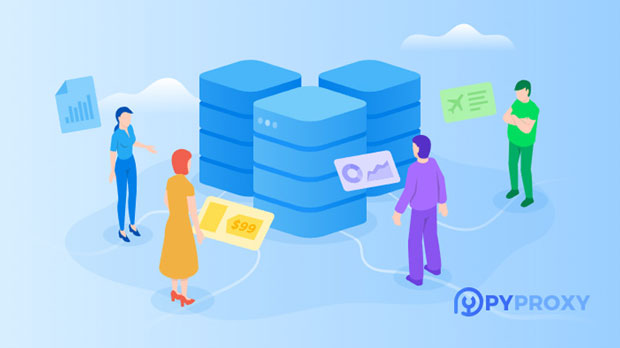The importance of maintaining a stable social media account cannot be overstated, particularly for businesses and individuals aiming to maximize their online presence. One of the most effective ways to ensure the stability of these accounts is through the use of proxies. Among the many proxy services available, PYPROXY ISP proxies stand out due to their unique capabilities in maintaining social media account stability. This article will explore how the PyProxy ISP Proxy function works and its impact on ensuring the smooth and secure operation of social media accounts, focusing on key features, advantages, and practical applications. 1. Understanding the Role of Proxies in Social Media Account StabilityIn the context of social media management, proxies play a crucial role in stabilizing and securing accounts by masking the user's real IP address. By routing internet traffic through multiple proxy servers, the use of proxies helps avoid detection, minimize the risk of account bans, and improve the overall performance of social media profiles. This process ensures that social media platforms do not flag accounts as spammy or engage in any behavior that could lead to temporary or permanent bans.For social media managers and digital marketers, this means a more consistent user experience. It helps in automating the management of multiple accounts, scheduling posts, and engaging with users without the fear of running into restrictions due to IP-related issues. PyProxy ISP proxies enhance this process by providing dedicated, stable connections, which further support the development of social media accounts.2. The Functionality of PyProxy ISP ProxiesPyProxy ISP proxies are a special type of proxy that uses Internet Service Provider (ISP) IPs to route traffic. Unlike traditional proxies that may use data center IPs, ISP proxies use real residential IP addresses assigned by Internet Service Providers, which means they appear more legitimate to social media platforms. This is vital in preventing account bans or restrictions, as social media algorithms are trained to detect suspicious patterns such as the use of data center IPs or VPNs.One of the standout features of PyProxy ISP proxies is their reliability and speed. Since they use real ISP IPs, they offer a more stable connection that mimics regular user behavior, ensuring smooth interactions with social media platforms. This stability is especially important when it comes to the maintenance of multiple accounts, as the risk of triggering security measures that may lead to account suspension is significantly reduced.3. How PyProxy ISP Proxies Enhance Social Media Account ManagementSocial media account management often requires a multi-faceted approach, involving various activities like posting content, liking and commenting, following accounts, and interacting with other users. In many cases, these activities are automated to save time and effort. However, automated actions performed from a single IP address can trigger red flags within social media algorithms, potentially leading to account restrictions or bans.By using PyProxy ISP proxies, businesses can distribute their activities across different IP addresses, simulating the behavior of multiple users interacting with the platform. This reduces the likelihood of the account being flagged for suspicious behavior, as it prevents actions from being linked to a single, identifiable IP. It also ensures that accounts can be managed more efficiently, as each proxy can be assigned to a specific task or account.Additionally, PyProxy ISP proxies offer greater anonymity and security, which is especially important for users who need to manage accounts across different regions or countries. With PyProxy, users can access social media platforms as if they were located in different locations, helping to avoid restrictions that may apply to certain regions.4. Avoiding IP Blocking and BansOne of the major risks associated with social media account management is the potential for IP blocking. Social media platforms, such as Instagram, Facebook, and Twitter, closely monitor IP addresses to detect and prevent spam, bot behavior, and other violations of their terms of service. When an account is flagged for suspicious activity, the platform may block the IP address associated with that account, making it impossible to access or manage the account without changing the IP.By using PyProxy ISP proxies, social media managers can avoid these IP-related issues. Since PyProxy ISP proxies use residential IPs, they are less likely to be detected as proxy servers by social media platforms. As a result, users can continue to manage their accounts without the constant threat of IP blocking or bans. This is particularly valuable for businesses that rely on social media for customer engagement and brand promotion.5. Managing Multiple Accounts with PyProxy ISP ProxiesManaging multiple social media accounts is a common practice for digital marketers and businesses. However, platforms like Instagram and Facebook often limit the number of actions that can be taken from a single IP address in a short time period. If too many actions (such as liking posts, following accounts, or sending messages) are performed from the same IP, the platform may temporarily or permanently block the associated account.PyProxy ISP proxies allow users to assign different IPs to each account, thus distributing the activity across multiple proxies. This approach enables users to manage many accounts simultaneously without triggering security measures that could lead to account suspensions. Furthermore, it provides a level of protection against potential bans or restrictions, as each account appears to be operated from a different, legitimate user.6. Ensuring Long-Term Account GrowthFor social media managers, the long-term success of an account relies on consistent and legitimate engagement. PyProxy ISP proxies help ensure that social media accounts maintain a steady growth trajectory by preventing the pitfalls associated with account bans and restrictions. The more stable and secure the account, the more opportunities it has for organic growth.By utilizing PyProxy ISP proxies, social media managers can focus on content creation, audience engagement, and strategic planning, rather than worrying about potential account suspensions or bans. The stable connection provided by PyProxy ensures that the account remains active and engaged, without the constant threat of losing access due to platform security measures.7. Real-World Applications of PyProxy ISP Proxies in Social MediaThe use of PyProxy ISP proxies is beneficial for various social media activities, including:- Automated Content Posting: Schedule and automate posts across multiple accounts without the fear of triggering platform security.- Ad Management: Run paid ads for different brands or clients from separate accounts, reducing the risk of being flagged as a spammy advertiser.- Brand Monitoring: Track brand mentions and competitor activity across social media platforms without attracting unwanted attention.- Market Research: Gather insights from different regions by accessing social media platforms through regional IPs, avoiding location-based restrictions.PyProxy ISP proxies offer a valuable tool for anyone managing social media accounts. By providing stable, secure, and legitimate connections, these proxies improve account stability, minimize the risk of bans or restrictions, and enable the smooth operation of multiple accounts. For businesses and digital marketers, utilizing PyProxy ISP proxies is a crucial step toward ensuring long-term growth and success on social media platforms. Through their unique functionality, PyProxy ISP proxies offer a strategic advantage that enhances account management efficiency and reduces the risks associated with social media account operations.
Nov 11, 2025


































































